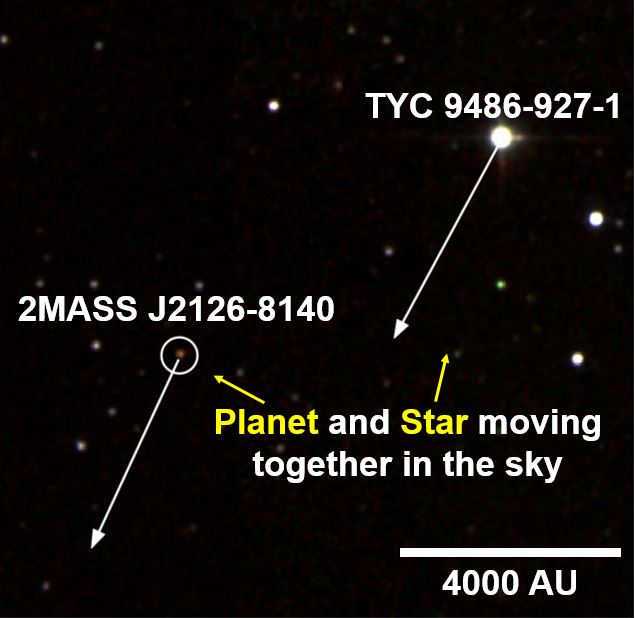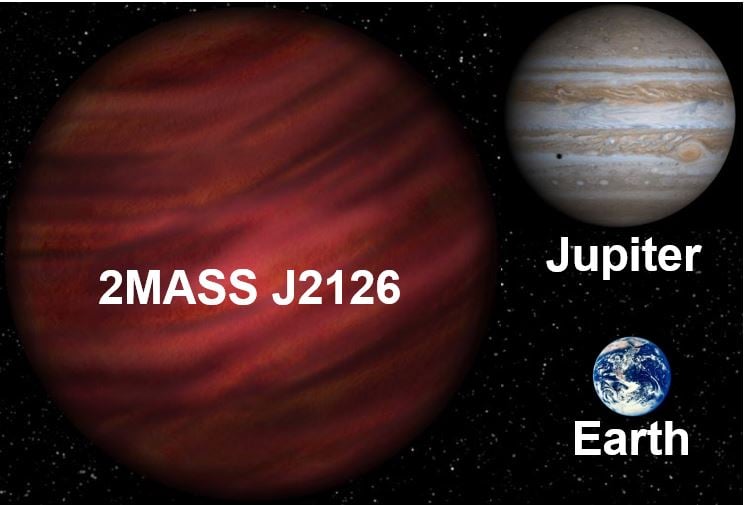Imagine a mega planet with up to 15 times the mass of Jupiter in a giant solar system 1 trillion km from its star, which is about seven thousand times further than our Earth is from the Sun – that is what a team of astronomers have discovered. This massive gas giant planet has the widest orbit detected so far in the Universe.
The British, Australian and American astronomers wrote about the fascinating planet, which is called 2MASS J2126, in the scientific journal Monthly Notices of the Royal Astronomical Society (pre-print arXiv citation below).
Initially, everybody had thought the object was a free-floating exoplanet – one that was not orbiting a star. An exoplanet is a planet outside our solar system.
 An artist’s rendering of 2MASS J2126, a massive gas planet with 11.6 to 15 times the mass of Jupiter. (Image: Royal Astronomical Society. Credit: University of Hertfordshire/Neil Cook)
An artist’s rendering of 2MASS J2126, a massive gas planet with 11.6 to 15 times the mass of Jupiter. (Image: Royal Astronomical Society. Credit: University of Hertfordshire/Neil Cook)
Since 2010, astronomers have discovered many free-floating planets. They are all extremely large worlds made of gas – like Jupiter – that do not have the mass stars have for nuclear reactions to make them shine brightly – eventually they cool and fade.
Lead author, Dr. Niall Deacon, a Postdoctoral Researcher at the University of Hertfordshire’s Centre for Astrophysics Research in the UK, and colleagues said that measuring the temperature of these large celestial objects is fairly simple. However, you first have to determine both their mass and age.
Scientists need to find out how old they are before they can determine whether they are light enough to be planets or dense enough to be brown dwarfs, i.e. failed stars that are not massive enough to sustain hydrogen-1 fusion reactions in their cores, like main-sequence stars do.
At first they thought is was free-floating
The giant gas planet was discovered by US-based astronomers in an infrared sky survey. They flagged it as potentially a young and therefore low-mass object. In 2014, some Canadian scientists identified 2MASS J2126 as perhaps a member of the Tucana Horologium Association – a group of brown dwarfs and stars about 45 million years old.
This made the planet young enough and sufficiently lightweight to be classed as a free-floating planet.
TYC 9486-927-1 is a star in the same region of the sky which astronomers have identified as being young. However, it is not a member of any known group of young stars. Before this latest study, nobody had any idea that the star TYC 9486-927-1 and giant gas planet 2MASS J2126 might be linked.
 False colour infrared image of the gas planet 2MASS J2126 and star TYC 9486-927-1. The arrows show the projected movement of the star and planet on the sky over a 1000-year period. The scale is in AU. One AU = 1 Earth-Sun distance. (Image: Royal Astronomical Society. Credit: 2MASS/S. Murphy/ANU)
False colour infrared image of the gas planet 2MASS J2126 and star TYC 9486-927-1. The arrows show the projected movement of the star and planet on the sky over a 1000-year period. The scale is in AU. One AU = 1 Earth-Sun distance. (Image: Royal Astronomical Society. Credit: 2MASS/S. Murphy/ANU)
Dr. Deacon has spent that past few years searching the skies for young stars that might have companion planets in distant orbits.
Dr. Deacon and colleagues gathered and analyzed mountains of data on free-floating planets, young stars and brown dwarfs to see whether one of them could be related.
They noticed that TYC 9486-927-1 and 2MASS J2126 are moving through space together and are about 104 light years from our Sun, an indication that they have a relationship.
A mega wide planetary system
Dr. Deacon said, regarding the size of this planetary system:
“This is the widest planet system found so far and both the members of it have been known for eight years, but nobody had made the link between the objects before. The planet is not quite as lonely as we first thought, but it’s certainly in a very long distance relationship.”
 2MASS J2126 is huge. It has 11.6 to 15 times the mass of Jupiter, which has 317 times the mass of Earth. (Not to scale)
2MASS J2126 is huge. It has 11.6 to 15 times the mass of Jupiter, which has 317 times the mass of Earth. (Not to scale)
After studying both the star and giant gas planet in more detail, the Dr. Deacon and colleagues were not able to confirm whether they were members of any group of stars known to scientists today.
Co-author Josh Schlieder, a NASA Postdoctoral Program Fellow at NASA Ames Research Center in Moffett Field, California, said regarding the age of young stars:
“Membership in a group of young stars is great for establishing an age, but when we can’t use that we need to resort to other methods.”
The team then looked at the dispersed light (spectrum) of the star to measure a feature caused by lithium, an element that is destroyed when stars are young. The younger a star is, the more lithium it has.
TYC 9486-927-1 had stronger lithium signatures than the 45-million-year-old Tucana Horologium Association stars have. However, less lithium was detected than in a group of stars estimated to be about 10 million years old. So, we know this star was born between 10 and 45 million years ago.
Now that they had an idea of the star’s age, the scientists were able to estimate what the mass of 2MASS J2126 is. They discovered it is a Goliath of a planet – from 11.6 to 15 times the mass of Jupiter (Jupiter has 317 times the mass of the Earth).
2MASS J2126’s mass placed it on the borderline between planets and brown dwarfs. This means that it has a similar mass, age and temperature to beta Pictoris b – one of the first planets directly imaged around another star.
Incredibly far from its star
Co-author Dr. Simon Murphy, a SkyMapper Postdoctoral Fellow at the Research School of Astronomy & Astrophysics, part of the Australian National University in Canberra, said:
“Compared to beta Pictoris b, 2MASS J2126 is more than 700 times further away from its host star, but how such a wide planetary system forms and survives remains an open question.”
2MASS J2126 is an incredible 1 trillion kilometres (621 billion miles) from its parent star, i.e. 7000 times the Earth’s distance from the Sun. It has the widest detected orbit of any exoplanet in the Universe. If there are wider orbits out there, we have not discovered them yet.
It takes this giant gas planet about 900,000 Earth years to complete one orbit around its star. As it is between 10 and 45 million years old, it probably has not completed 50 orbits yet during its relatively short life.
The scientists are fairly sure that there is no life (as we know it) on the planet. However, if there were and they had eyes and looked up at the sky, their distant sun would just be a bright star in the sky. They would have no idea their planet was connect to it.
In an Abstract in the journal, the authors wrote:
“Because of their extreme separation and youth, this low-mass pair provide an interesting case study for very wide binary formation and evolution.”
Reference: “A nearby young M dwarf with a wide, possibly planetary-mass companion,” S.J. Murphy, N.R. Deacon & J.E. Schlieder. Monthly Notices of the Royal Astronomical Society. 16 January 2016. Currently posted in the pre-publication arXiv database (http://arxiv.org/abs/1601.06162).
Video – Incredibly large solar system
Discover more from Market Business News
Subscribe to get the latest posts sent to your email.

